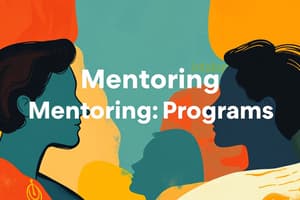Podcast
Questions and Answers
What was the application deadline for the mentoring program?
What was the application deadline for the mentoring program?
- 09/11/00
- 10/5/00 (correct)
- 10/10/00
- 10/24/00
On which date was the matching of pairs designated?
On which date was the matching of pairs designated?
- 10/13/00
- 10/6/00
- 10/10/00
- 10/11/00 (correct)
Which audience was targeted for the 'Guest speaker on mentoring' event?
Which audience was targeted for the 'Guest speaker on mentoring' event?
- GLC circle groups
- All participants (correct)
- Mentors
- Mentees
What activity was scheduled for 6/20/2001?
What activity was scheduled for 6/20/2001?
What was the primary goal of the orientation and training conducted from 10/23/00 to 10/24/00?
What was the primary goal of the orientation and training conducted from 10/23/00 to 10/24/00?
Which month included orientation for circles?
Which month included orientation for circles?
What type of event was held on 7/25/2001?
What type of event was held on 7/25/2001?
When were selected staff notified of their involvement in the mentoring program?
When were selected staff notified of their involvement in the mentoring program?
What was the last activity listed in the Program Roll-out Timeline?
What was the last activity listed in the Program Roll-out Timeline?
Which of the following is part of the ADDIE Model?
Which of the following is part of the ADDIE Model?
The Six Disciplines of Breakthrough Learning includes training methods that do not emphasize results.
The Six Disciplines of Breakthrough Learning includes training methods that do not emphasize results.
What are the strengths of the ADDIE Model?
What are the strengths of the ADDIE Model?
What is one criticism of the ADDIE Model?
What is one criticism of the ADDIE Model?
Match the components of the Six Disciplines of Breakthrough Learning:
Match the components of the Six Disciplines of Breakthrough Learning:
The philosophy that emphasizes tangible results in training is called _____
The philosophy that emphasizes tangible results in training is called _____
Flashcards are hidden until you start studying
Study Notes
Overview of the Mentoring Program
- Launched in September 2000, the Federal Reserve Bank of Chicago's formal mentoring program aimed to enhance employee development and retention.
- Initially included 25 mentor-mentee pairs supported by 4 circle groups.
- Program manager Amy Rubinstein played a critical role in facilitating relationships and fostering enthusiasm among participants.
Pilot Program Success and Challenges
- Positive feedback from mentees indicated high satisfaction and loyalty to the Bank.
- Despite success, the application rate for the second round was lower than expected, prompting concerns from senior management regarding its sustainability and expansion.
Federal Reserve System Structure
- The Federal Reserve Bank of Chicago is one of 12 regional reserve banks under the Federal Reserve System, which includes a Board of Governors in Washington, D.C.
- The Chicago district encompasses northern Illinois, Iowa, northern Indiana, southern Michigan, and southern Wisconsin, employing approximately 2,000 staff as of 2000.
Cultural Context and Change
- Historically, the Bank's culture was characterized by low morale and a formal, authoritarian environment, which prompted a culture survey in 1995.
- Management responded by initiating the "Fresh Look" project in 1996, aiming to foster innovation, open communication, and employee empowerment.
- The program targeted leadership, performance management, communication, skill development, and customer focus.
Initial Proposal for Mentoring
- The need for a mentoring program was recognized during discussions among managers; however, initial proposals faced resource allocation challenges and were deprioritized.
- Focus on a Diversity Initiative in 1997 led to mentoring being identified as a key strategy.
Development and Launch of Mentoring Program
- After revisiting the proposal in 2000, an executive sponsor was appointed, leading to the formation of an advisory group.
- Advisory group included stakeholders from various departments and aimed for a program design that addressed inclusion, skill development, and communication.
Program Eligibility and Marketing
- Eligible participants must have been employed for at least one year, in good standing, have effective performance ratings, and commit to 4 hours monthly for one year.
- Marketing strategies included creating promotional materials, holding information sessions, and direct outreach during lunch hours to increase awareness and interest.
Participant Selection Process
- Initially planned for 25 mentors and 25 mentees; ultimately, 37 mentors and 44 mentees applied.
- Selection criteria focused on access to opportunities and matching applicants based on coaching experience and relationship interests.
Matching and Training
- The matching process prioritized non-hierarchical relationships and compatibility based on personalities and professional goals.
- Training sessions for participants included role descriptions, goal setting, and dialogue skills, using tools like the DISC inventory to enhance communication and understanding.
Goals of the Mentoring Program
- Aimed to provide career development support and enhance employee retention by fostering meaningful mentor-mentee relationships.
- Emphasized that mentors serve as sounding boards allowing mentees to lead discussions and establish their own development goals.### Circle Mentoring Program
- Circle mentoring involves groups of 6 to 10 people with shared interests meeting with one or two mentors.
- Affinity groups include the Graduate Leadership Council (GLC) for employees in or recently completed graduate programs, and the Higher Education Resource Organization (HERO) supporting employees considering further education.
- Four mentoring circles were established, focusing on different developmental goals.
Program Management and Challenges
- Program Manager Rubinstein frequently checked on participants to maintain motivation and resolve issues between mentors and mentees.
- Training for the circle program occurred in November 2000, with a similar structure to pairs training.
- Rubinstein developed a resource library on mentoring and organized monthly lunch meetings for networking.
Evaluation and Support
- Participants underwent one-month, three-month, and six-month evaluations for program effectiveness, with a final survey planned for feedback.
- Senior management including Bank President Moskow supported the program by engaging with mentees and acknowledging mentors' contributions through events and recognition.
Informal Support Networks
- Mentees formed an informal support network, assisting peers in overcoming challenges and enhancing program utilization.
- Peer connections proved beneficial, with plans for informal gatherings post-program completion to continue mutual support.
Impact on Retention and Employee Development
- Within nine months, 7 out of 25 mentees were promoted, highlighting the program's positive influence on career advancement.
- Individual stories, such as those of mentees like Pat Brunner and Mary Jo Huck, illustrate how mentoring facilitated greater awareness of internal opportunities and boosted confidence.
Benefits for Mentors
- Mentors also experienced personal growth and improved job satisfaction, with examples of encouragement leading them to pursue further education through the Bank’s tuition assistance program.
Second Round of the Program
- A second round in summer 2001 aimed to include 30 pairs, with adjustments made based on pilot feedback, such as condensing training to one day.
- Only 23 mentors and 22 mentees applied, which was surprising given the initial demand and success of the program.
Future Considerations
- Advisory group members deliberated on expanding the program to accommodate additional participants without sacrificing its personalized nature, recognizing both high demand and the effective impact of smaller groups.
Program Administration
- The advisory group consisted of diverse members from various departments, including HR, diversity, and training.
- The matching process focused on aligning mentor and mentee goals and included a statement noting that participation did not guarantee promotions but fostered professional growth.
Key Insights
- Mentees' and mentors' experiences suggest that structured mentoring programs can significantly enhance employee engagement, career development, and morale within an organization.### Distribution of Mentee Applicants
- Total applicants: 44, categorized by salary grade and race/gender
- Highest number of African-American females: 19; predominant mentee group
- Notable applicants from salary grade 11: 10 total (2 African-American females, 7 Caucasian females, 1 Hispanic female)
- Lowest representation from Hispanic applicants (1 male, 1 female)
- Salary grades 4 and 6 had fewest total applicants (2 and 4 respectively)
Distribution of Mentor Applicants
- Total applicants: 37, with a breakdown by salary grade and race/gender
- Most mentors from Caucasian males (17 total); significant participation from Caucasian females (11)
- Salary grade 14 had the highest number of mentors overall (8: 1 African-American male, 1 African-American female, 3 Caucasian males)
- Asian females represented as mentors with 2 total
- Assistant VP level had significant mentor representation (7 total)
Program Roll-out Timeline
- Program initiation and presentation to management: September 11, 2000
- Marketing and applications distributed between September 11 and October 5, 2000
- Application deadline set for October 5, 2000
- Application screening occurred on October 6, 2000
- Pair matching designated on October 10 and completed by October 11, 2000
- Selected staff notified on October 13, 2000
- Orientation and training sessions held on October 23 and 24, 2000
- First orientation for circles scheduled for November 2000
Sample Event Schedule for Program Participants
- Key program events included career mapping for mentees, coaching meetings for mentors, and guest speaker events
- Notable events:
- Mapping Your Career for mentees on March 29, 2001
- Guest speaker sessions for all participants on May 22, 2001
- Volunteer activity planned for all participants on July 25, 2001
- Regular breakfast meetings for mentors and mentees scheduled throughout the program
Instructional System Design
- Encompasses various elements of curriculum design and development.
- Key models include the ADDIE Model and Miller’s Approach to Systematic Training.
ADDIE Model
- Stages consist of Analysis, Design, Development, Implementation, and Evaluation.
- Each phase contributes to a systematic approach for effective instructional design.
Miller’s Approach to Systematic Training
- Emphasizes the importance of Evaluation and Design within the training process.
- Highlights a structured methodology for delivering effective learning experiences.
Strengths and Criticisms of ADDIE
- Strengths:
- Comprehensive and systematic framework for instructional design.
- Flexible enough to adapt to various training needs.
- Weaknesses:
- Can be overly linear and constraining, causing delays.
- May lead designers to overlook critical elements in phases following design.
- Lacks emphasis on transfer of learning, which is essential for effective training.
The Six Disciplines of Breakthrough Learning
- Focuses on six key areas:
- D1: Define Business Outcomes
- D2: Design Complete Experience
- D3: Deliver for Application
- D4: Drive Learning Transfer
- D5: Deploy Performance Support
- D6: Document Results
Result-Based Approach (Phillips)
- Prioritizes achieving measurable results as a core training philosophy.
- Involves line managers actively in the training process for greater effectiveness.
- A comprehensive evaluation plan is critical for assessing training outcomes.
Upcoming Session
- Focus will be on needs assessment and objective setting.
- Preparation includes reviewing specific templates and a case study related to Linear Network Systems.
Studying That Suits You
Use AI to generate personalized quizzes and flashcards to suit your learning preferences.




